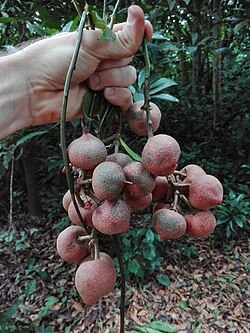Pentadin
 From Wikipedia - Reading time: 4 min
From Wikipedia - Reading time: 4 min
| Defensin-like protein | |||||||
|---|---|---|---|---|---|---|---|
| Identifiers | |||||||
| Organism | |||||||
| Symbol | ? | ||||||
| UniProt | P56552 | ||||||
| |||||||
Pentadin, a sweet-tasting protein, was discovered and isolated in 1989 from the fruit of oubli (Pentadiplandra brazzeana Baillon), a climbing shrub growing in some tropical countries of Africa.[1] Pentadiplandra brazzeana berry consists of a red pericarp with seeds and flesh containing sweet tasting proteins that can be extracted for production of a sugar substitute.[1]
History
[edit]Pentadin (discovered in 1989) and brazzein[2] (discovered in 1994) are the two names proposed for the sweet-tasting protein(s) isolated via two different methods from the same African fruit, Pentadiplandra brazzeana. The corresponding author of both these publications has later opined that pentadin and brazzein are two different names for the same protein.[3] Even though pentadin is the earlier proposed name, brazzein is the more commonly used name after more extensive characterisation of the sweet protein.[2]
Description
[edit]
Sweet tasting proteins have been known to exist for many years and indigenous people have been known to use these proteins as a way to add sweetness to their foods without the use of other sweetening agents, such as sucrose.[5] The sweetness of pentadin/brazzein has been estimated to be about 500 times more than sucrose, on a weight basis.[5] This sweet tasting protein is known to resemble monellin on a sweetness basis and is higher than thaumatin.[6]

There are five sweet-tasting proteins - thaumatin, monellin, mabinlin, brazzein/pentadin, and curculin - all of which are isolated from plants in tropical forests. These proteins show no similarities in a structural or homologous sequence aspect. All of these sweet tasting proteins have different molecular lengths, with no sequence homology and little to none structural homology. Efforts to identify structural similarities among sweet tasting proteins included using the 3D structures and DALI to find similarities. However only a vague resemblance was found for the three proteins tested, monellin, thaumatin, and brazzein.[7][8]
Uses
[edit]The five sweet-tasting proteins are possibly useful to manufacture a low-calorie sweetener to replace certain sugars.[9][10]
See also
[edit]References
[edit]- ^ a b Wel HV, Larson G, Hladik A, Hladik CM, Hellekant G, Glaser D (1989). "Isolation and characterization of pentadin, the sweet principle of Pentadiplandra brazzeana Baillon" (PDF). Chemical Senses. 14 (1): 75–79. doi:10.1093/chemse/14.1.75.
- ^ a b Ming D, Hellekant G (November 1994). "Brazzein, a new high-potency thermostable sweet protein from Pentadiplandra brazzeana B". FEBS Letters. 355 (1): 106–108. Bibcode:1994FEBSL.355..106M. doi:10.1016/0014-5793(94)01184-2. PMID 7957951. S2CID 6650703.
- ^ Picone D, Temussi PA (2012). "Dissimilar sweet proteins from plants: Oddities or normal components?". Plant Science. 195 (2012): 135–142. Bibcode:2012PlnSc.195..135P. doi:10.1016/j.plantsci.2012.07.001.
- ^ Zheng X, Yi TS (November 2019). "The plastid genome of Pentadiplandra brazzeana Baillon (Pentadiplandraceae)". Mitochondrial DNA. Part B, Resources. 4 (2): 4002–4003. doi:10.1080/23802359.2019.1688102. PMC 7707644. PMID 33366290.
- ^ a b Faus I (February 2000). "Recent developments in the characterization and biotechnological production of sweet-tasting proteins". Applied Microbiology and Biotechnology. 53 (2): 145–151. doi:10.1007/s002530050001. PMID 10709975. S2CID 31882473.
- ^ a b Bilal M, Ji L, Xu S, Zhang Y, Iqbal HM, Cheng H (April 2022). "Bioprospecting and biotechnological insights into sweet-tasting proteins by microbial hosts-a review". Bioengineered. 13 (4): 9815–9828. doi:10.1080/21655979.2022.2061147. PMC 9161876. PMID 35435127.
- ^ Temussi PA (August 2002). "Why are sweet proteins sweet? Interaction of brazzein, monellin and thaumatin with the T1R2-T1R3 receptor". FEBS Letters. 526 (1–3): 1–4. Bibcode:2002FEBSL.526....1T. doi:10.1016/S0014-5793(02)03155-1. PMID 12208493. S2CID 32490657.
- ^ Kurihara Y, Nirasawa S (1994-02-01). "Sweet, antisweet and sweetness-inducing substances". Trends in Food Science & Technology. 5 (2): 37–42. doi:10.1016/0924-2244(94)90069-8. ISSN 0924-2244.
- ^ Sharififar F, Ashrafzadeh A, Kavirimanesh Khanaman M (2022-10-31). "A Review of Natural Peptide Sweeteners". International Journal of Peptide Research and Therapeutics. 28 (6): 158. doi:10.1007/s10989-022-10464-4. ISSN 1573-3904. S2CID 253226799.
- ^ Kant R (February 2005). "Sweet proteins--potential replacement for artificial low calorie sweeteners". Nutrition Journal. 4 (1): 5. doi:10.1186/1475-2891-4-5. PMC 549512. PMID 15703077.
 KSF
KSF